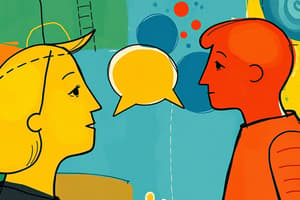Podcast
Questions and Answers
What is communication?
What is communication?
The process by which messages are transferred from source to a receiver.
What are the two types of communication?
What are the two types of communication?
- Verbal communication
- One-way communication (correct)
- Nonverbal communication
- Two-way communication (correct)
One-way communication is characterized by the absence of feedback from the receiver.
One-way communication is characterized by the absence of feedback from the receiver.
True (A)
Two-way communication uses feedback from the receiver.
Two-way communication uses feedback from the receiver.
What are two types of verbal communication?
What are two types of verbal communication?
What is written communication?
What is written communication?
What are the functions of verbal communication?
What are the functions of verbal communication?
What is nonverbal communication?
What is nonverbal communication?
Nonverbal communication is a more powerful way of communicating than verbal communication.
Nonverbal communication is a more powerful way of communicating than verbal communication.
What are six functions of nonverbal communication?
What are six functions of nonverbal communication?
What is kinesics?
What is kinesics?
Facial expressions are a type of kinesics.
Facial expressions are a type of kinesics.
Gestures are a type of kinesics.
Gestures are a type of kinesics.
What is paralanguage?
What is paralanguage?
Shaky voice reveals nervousness.
Shaky voice reveals nervousness.
A clear voice reveals confidence.
A clear voice reveals confidence.
What are the three types of formal communication?
What are the three types of formal communication?
What is upward communication?
What is upward communication?
What is horizontal communication?
What is horizontal communication?
What is interpersonal communication?
What is interpersonal communication?
Flashcards
Communication
Communication
The process by which messages are transferred from source to receiver.
One Way Communication
One Way Communication
Communication characterized by absence of feedback from the receiver.
Two Way Communication
Two Way Communication
Involves active feedback from the receiver to ensure understanding.
Verbal Communication
Verbal Communication
Signup and view all the flashcards
Oral Communication
Oral Communication
Signup and view all the flashcards
Written Communication
Written Communication
Signup and view all the flashcards
Functions of Verbal Communication
Functions of Verbal Communication
Signup and view all the flashcards
Nonverbal Communication
Nonverbal Communication
Signup and view all the flashcards
Functions of Nonverbal Communication
Functions of Nonverbal Communication
Signup and view all the flashcards
Kinesics
Kinesics
Signup and view all the flashcards
Facial Expressions
Facial Expressions
Signup and view all the flashcards
Gestures
Gestures
Signup and view all the flashcards
Paralanguage
Paralanguage
Signup and view all the flashcards
Formal Communication
Formal Communication
Signup and view all the flashcards
Upward Communication
Upward Communication
Signup and view all the flashcards
Downward Communication
Downward Communication
Signup and view all the flashcards
Horizontal Communication
Horizontal Communication
Signup and view all the flashcards
Informal Communication
Informal Communication
Signup and view all the flashcards
Inter-Personal Communication
Inter-Personal Communication
Signup and view all the flashcards
Intrapersonal Communication
Intrapersonal Communication
Signup and view all the flashcards
Study Notes
Communication Overview
- Communication is the process of transferring messages from a source to a receiver.
- Rogers and Shoemaker defined communication as the process by which messages are transferred from source to receiver.
Types of Communication
One-Way Communication
- One-way communication lacks feedback from the receiver.
- An example is a teacher lecturing to students.
Two-Way Communication
- Two-way communication includes active feedback from the receiver to the sender.
- It is essential for ensuring the receiver understands the message as intended.
Verbal Communication
- Verbal communication uses symbols with commonly understood meanings.
- Includes oral and written forms.
Oral Communication
- Information is exchanged through spoken words.
Written Communication
- Information is exchanged through written or printed words.
Functions of Verbal Communication
- Organizing and controlling behavior and events
- Completing tasks.
- Building and maintaining relationships.
- Satisfying personal needs.
- Acquiring knowledge.
- Expressing events and knowledge.
Nonverbal Communication (NVC)
- Nonverbal communication transmits meaning apart from written or spoken words.
- Communication cues include facial expressions, body posture, kinesics, chronemics, proxemics, and appearance.
Functions of Nonverbal Communication
- Strengthening
- Complementing
- Contradicting
- Controlling
- Repeating
- Replacing
Kinesics
- The study of body movements to interpret inner emotions.
Facial Expressions
- Facial expressions convey emotions (e.g., happiness, sadness, anger).
Gestures
- Body movements communicate a variety of emotions.
Posture
- Body positioning can communicate emotions (e.g., confidence, discomfort).
Proxemics
- The study of personal space, including intimate, personal, social, and public.
Paralanguage
- Paralanguage studies voice quality, volume, speed, and spoken manner.
- A shaky voice may indicate nervousness, while a clear voice may indicate confidence.
Formal Communication
- Structured communication based on organizational hierarchy and authority.
Types of Formal Communication
Upward Communication
- Messages flowing from subordinates to superiors.
Downward Communication
- Messages flowing from superiors to subordinates in an organization's hierarchy.
Horizontal Communication
- Messages flowing among colleagues.
Informal Communication
- Less structured and spontaneous communication from daily routines.
Interpersonal Communication
- Communication between two or more individuals. It is essential to everyday life.
Intrapersonal Communication
- Internal dialogue within an individual’s mind. May be clear or confused depending on the individual.
Studying That Suits You
Use AI to generate personalized quizzes and flashcards to suit your learning preferences.




